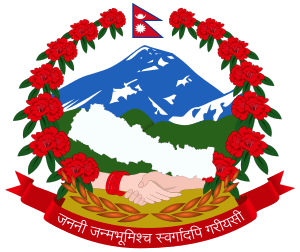Rana dynasty
| Rana dynasty राणा वंश | |
|---|---|
 | |
| Country |
|
| Ethnicity | Khas Rajput (Chhetri) |
| Founded | 1846 A.D |
| Founder | Jung Bahadur Rana |
| Current head | presently as pretender |
| Final ruler | Mohan Shumsher |
| Titles | |
| Religion | Hinduism |
| Estate(s) | Rana palaces of Nepal |
| Deposition | 1951 A.D |
Part of a series on the |
|---|
| History of Nepal |
 |
|
| Timeline |
|
|
Rana dynasty (Nepali: राणा वंश; IAST:Rāṇā vanśa) is a Khas Rajput (Chhetri)[note 1] dynasty from the Indian subcontinent[3] that ruled the Kingdom of Nepal from 1846 A.D until 1951 A.D, reducing the Shah monarch to a figurehead and making Prime Minister and other government positions hereditary.[4][5] This changed in 1951 with the promulgation of a new constitution, when power shifted back to the monarchy of King Tribhuvan.[6]
Genealogy
Chronicler Daniel Wright has published the genealogy of Jang Bahadur Kunwar Rana. The genealogy begins with Tattā Rāṇā as Raja (King) of Chittaurgarh.[7] His nephew Fakht Siṃha Rāṇā had a son named Rāma Siṃha Rāṇā, who came to hills after the siege of Chittaur.[7] He was employed by a hill Raja for ten or twelve months who wanted to retain Rāma Siṃha in his country. The hill Raja asked for the daughter of Raja of Bīnātī, a Bagāle Kṣetrī and married her to Rāma Siṃha.[7] They had six sons over 10-12 years, one of whom was recognized by the title of Kum̐vara Khaḍkā for bravery displayed in the battle against Raja of Satān Koṭ.[7] The title was used by his descendants. Rāma Siṃha was suddenly met by his younger brother who requested him to return Chittaur for once and Rāma Siṃha died reaching there.[8] The hill Raja made Rāma Siṃha's son Rāut Kunwar a nobleman (Sardār) and commandant of the army.[8] Ahirāma Kunwar, a son of Rāut Kunwar, was invited by King of Kaski and was made nobleman with a birta or jagir of Dhuage Saghu village.[8] King of Kaski asked the hand of Ahirāma's daughter, who was a great beauty through only Kalas Puja to which Ahirāma replied to give his daughter only through lawful marriage.[8] King brought his troops and tried to take on the village by force.[8] Ahirāma was supported by the villagers belonging to Parājulī Thāpā caste and a war was initiated.[8] On the same day, Ahirāma took his immediate family including two sons namely; Ram Krishna Kunwar and Jaya Krishna Kunwar, to King of Gorkha, Prithvi Narayan Shah where lands of Kunwar-Khola was given to them as birta.[9]
John Whelpton opines that Kunwar origin legend which states that first of their ancestors to enter hill married a daughter of Bagale Kshetri might have directed their family links to Bagale Thapa, the clan of Mukhtiyar Bhimsen Thapa.[10]
Rana dynasts; Prabhakar, Gautam and Pashupati Shamsher Jang Bahadur Rana claim the descent of Ranas of Nepal from Kunwar Kumbhakaran Singh, younger brother of Guhila King of Mewar, Rawal Ratnasimha. During the first siege of Chittorgarh in 1303 A.D., Kumbhakaran Singh's descendants left Mewar to north towards Himalayan foothills.[11]
Historical background
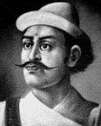
The founder of this dynasty was Jang Bahadur Rana, who belonged to Kunwar family which was then considered a minor noble family of Kshatriya status.[12] Jang Bahadur was a son of Gorkhali governor Bal Narsingh Kunwar and nephew of Mathabarsingh Thapa[13], the reigning Prime Minister of Nepal (1843–1845) from the Thapa dynasty.[14] Bal Narsingh Kunwar was the son of Kaji Ranajit Kunwar and grandson of Sardar Ram Krishna Kunwar[15], who was prominent military general of King Prithvi Narayan Shah.[16][17] Ram Krishna Kunwar was born to Ahiram Kunwar.[15] There were ample of rewards and recognitions received by Sardar Ram Krishna Kunwar from the Gorkhali monarch Prithvi Narayan.[18] His grandson Bal Narsingh was initially a follower of the renounced King Rana Bahadur Shah and Kaji Bhimsen Thapa, and followed the King in his exile to Banaras on 1 May 1800.[19] On the night of 25 April 1806, King Rana Bahadur was killed by step-brother Sher Bahadur in desperation after which Bal Narsingh immediately killed the King's assassin.[20][21][22] He was a close ally of the influential minister Bhimsen Thapa[20], who initiated a great massacre at Bhandarkhal garden following the chaos from the King's murder.[23][24][25] Following closeness to Mukhtiyar Bhimsen, he became the son-in-law of Bhimsen's brother Kaji Nain Singh Thapa of Thapa dynasty.[2] The close relatives and supporters of Thapa faction replaced the old courtiers and administrators.[23] The Kunwar family came to power being relatives of powerful Mukhtiyar Bhimsen Thapa. Similarly, Kunwars were related to Pande dynasty by their maternal grandmother Rana Kumari Pande who was daughter of Mulkaji Ranajit Pande.[2]
Rise of Jang Bahadur
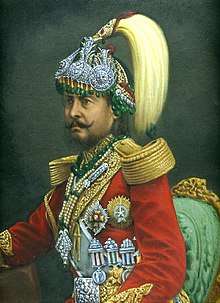
Bal Narsingh's son Kaji Jang Bahadur Kunwar became a significant person in the central politics of Nepal during the prime ministership of his uncle Mathabar Singh Thapa.[16] On 17 May 1845 around 11 pm, Mathabar Singh was summoned to the royal palace and was assassinated in a cold blood by Jang Bahadur on the royal orders.[16] He was considered to have been merciless, ruthless and fatal due to his association with Mathabar Singh.[16] Jang Bahadur was made a Kaji (equivalent to minister) after following the order of assassination of Mathabar.[12] On the night of 14 September 1846, Queen Rajya Lakshmi Devi summoned the courtiers on the mysterious murderer of her aide General Kaji Gagan Singh Bhandari, to which courtiers hurried to the Kot quickly.[26] Many of the courtiers were unarmed except for a sword, as they had responded immediately to the royal summons. The armies allocated by Jung Bahadur Rana also had taken most of the arms of courtiers who had managed to bring them. Queen Rajya Lakshmi Devi and King Rajendra Bikram Shah were also present in the Kot.[27] Queen Rajya Lakshmi demanded the execution of Kaji Bir Keshar (Kishor) Pande on alleged suspicion to which General Abhiman Singh Rana Magar looked towards King for confirmation. Jang misinformed Queen that Abhiman Singh's troops were arriving for overpowering the Queen's faction and demanded an immediate arrest.[12] Abhiman tried to force his way out and was killed by Jang's soldier. In the chaos followed, Jang and his brothers began bloodshed and many rival nobles and courtiers were eliminated by them.[28] The letter to British Resident Henry Montgomery Lawrence stated that there were 32 Bharadars (courtiers) killed in the massacre.[29]
Bhandarkhal massacre episode
When Jang refused the Junior Queen's request to place Prince Ranendra in the place of Crown Prince Surendra of Nepal, the Queen secretly contacted the victims of Kot and conspired to assassinate Jung Bahadur in the royal Bhandarkhal garden. After receiving a command from the Queen to come to Bhandarkhal, Jang Bahadur took his fully armed troops and headed towards the garden. The troops killed the chief conspirator, Birdhwaj Basnyat on the way, and marched towards Bhandarkhal where seeing Jang Bahadur approach fully armed with his troops, the other conspirators started to flee. 23 people were killed in the massacre while 15 escaped.[30] In the 23rd of September 1846, all officers of military and bureaucracy were called upon to their respective offices within 10 days. Then, Jung Bahadur appointed his brothers and nephews to the highest ranks of the government.[31] He consolidated the position of premiership after conducting Kot massacre (Kot Parva) and Bhandarkhal Parva[32] on the basic templates provided by his maternal grand-uncle Mukhtiyar Bhimsen Thapa.[13]
Rana Regime; Rule of Jang
After the massacres of Kot and Bhandarkhal, the Thapas, Pandes, Basnyats and other citizens had settled in Banaras. Similarly, some citizens had gone to settle in Nautanwa and Bettiah. Chautariya Guru Prasad Shah too had gone to live with the King of Bettiah. After knowing about the presence of the King and the Queen in Benaras, Guru Prasad went there and started to congregate an army and a plan to execute Jung Bahadur started to be formed.[31]
Battle of Alau
In May 12, 1847, Jung Bahadur gave a speech in Tundikhel. There he accused the King of the attempted assassination of the Prince and the Prime Minister. The Council then decided to dethrone King Rajendra deeming him mentally ill, and on the same day Surendra was crowned as the new king of Nepal. Hearing the news of the coronation of Surendra, Rajendra decided to take the responsibility of removing Jung Bahadur upon himself and declaring himself as the leader of the army, he left Benaras. Rajendra then appointed Guru Prasad Shah as the Chief of the Army for the operation of removal of Jung Bahadur Rana from Nepal and started to accumulate weapons and training the troops. Antagonism from the British-India Company forced Rajendra and his troops to enter Nepal. On the 23rd of July, the troops reached a village called Alau in Bara and set a camp there. One spy group of the Government of Nepal was keeping close eyes on the event of the rebel groups at Bettiah. They sent the news to Jung Bahadur, immediately after which he sent a troop in the leadership of Sanak Singh Tandon to Alau. They were told to suppress the rebellions, arrest Rajendra and bring him to Kathmandu. On the 27th of July, the Gorakhnath Paltan (Gorakhnath Battalion) reached and rested in a village called Simraungadh, not too far from Alau. The battle of Alau was a decisive one between the forces of King Rajendra and Jang Bahadur. The King lost significantly in the battle. If the massacre of Kot had established Jung Bahadur as a dictator, the battle of Alau had helped him strengthen his dictatorship. Rajendra was imprisoned in an old palace in Bhaktapur.[31]
Rise to royalty
On 15 May 1848, a Lal Mohar (Red sealed document) was issued claiming descent from Ranas of Mewar and authorizing the Kunwar family of Jang Bahadur to style themselves as Kunwar Ranaji.[33] On 6 August 1856, Jang Bahadur Kunwar (now Ranaji) was conferred the title of Maharaja (Great King) of Kaski and Lamjung, two former hill principalities, by King of Nepal, Surendra Bikram Shah.[34]
Rana Regime; Rule of the Shamshers
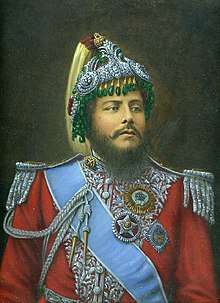
In 1885, the Shumsher family, the nephews of Jang Bahadur, murdered many of the sons of Jung Bahadur and took over Nepal in a military coup d'état thus bringing in the rule of the Shamsher Rana family also known as the Satra Bhai (17 brothers) Rana family. They murdered Sri Teen Maharaja Ranodip Singh and occupied the hereditary throne of Prime Minister. After this they added Jang Bahadur to their name, although they were descended from Jang's younger brother Dhir Shamsher[2]
Kunwar family tree
| Ram Krishna Kunwar | |||||||||||||||||||||||||||||||||||||||||||||||||||||||||||||||||||||
| Ranajit Kunwar | |||||||||||||||||||||||||||||||||||||||||||||||||||||||||||||||||||||
| Bal Narsingh Kunwar | Balaram Kunwar | Rewant Kunwar | |||||||||||||||||||||||||||||||||||||||||||||||||||||||||||||||||||
| Bhakta Bir Kunwar | Jang Bahadur Kunwar | Bam Bahadur Kunwar | Badri Narsingh Kunwar | Jaya Bahadur Kunwar | Krishna Bahadur Kunwar | Ranauddip Singh Kunwar | Jagat Shamsher Kunwar | Dhir Shamsher Kunwar | |||||||||||||||||||||||||||||||||||||||||||||||||||||||||||||
Rana Prime Ministers
Nine Rana rulers took the hereditary office(s) of Prime Minister, Supreme Commander-in-Chief and Grand Master of the Royal Orders. All were styled Maharaja of Lamjung and Kaski.
- Ranjit Kunwar Rana (1723–1815)
- Bal Narsingh Kunwar Rana (1783–1841)

- Bam Bahadur Kunwar Rana (1818 – 25 May 1857; Prime Minister: 1 August 1856 – 25 May 1857)

- General Sri Dhir Shumshere Jung Rana Bahadur (1828–1884)



-

-

-

-
-

- Bal Narsingh Kunwar Rana (1783–1841)
Succession
Succession to the prime ministership and the title of Maharaja of Lamjung and Kaski was by agnatic seniority, by which the oldest male heir among the sons of equal (a-class) marriages in a generation would succeed. The order of succession was determined by seniority, with each eligible male heir holding a military command, as follows:
- Prime Minister and Commander-in-Chief (Mukhtiyar the Heir Apparent, with the rank of Field Marshal)
- Western Commanding-General.
- Eastern Commanding-General.
- Southern Commanding-General.
- Northern Commanding-General.
Gallery
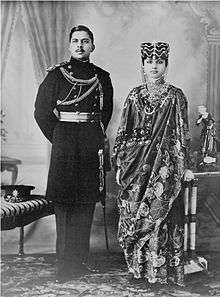 Major-General Vishnu Shamsher Rana and wife
Major-General Vishnu Shamsher Rana and wife Commanding General Babar Shumsher Rana and family
Commanding General Babar Shumsher Rana and family Dhir Shamsher Rana and sons make up Shamsher Rana dynasty
Dhir Shamsher Rana and sons make up Shamsher Rana dynasty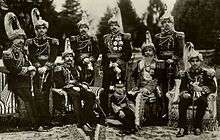 Chandra Shamsher and sons
Chandra Shamsher and sons
See also
References
Footnotes
- ↑ Founder of this dynasty Jang Bahadur Rana was a noble of Khas group who renamed Khas as Kshetri (क्षेत्री) borrowed from Kshatriya.[1] He had Kunwar (surname) and had direct blood relations with Khas Thapa dynasty of Mukhtiyar Bhimsen Thapa and Pande Chhetri family of Ranajit Pande.[2]
Notes
- ↑ Dor Bahadur Bista (1991). Fatalism and Development: Nepal's Struggle for Modernization. Orient Blackswan. ISBN 978-81-250-0188-1.
- 1 2 3 4 JBR, PurushottamShamsher (1990). Shree Teen Haruko Tathya Britanta (in Nepali). Bhotahity, Kathmandu: Vidarthi Pustak Bhandar. ISBN 99933-39-91-1.
- ↑ Van PraaghD (2003). Greater Game. MQUP. p. 319. ISBN 978-0-7735-7130-3. Archived from the original on 11 September 2017. Retrieved 11 September 2017.
- ↑ Dietrich, Angela (1996). "Buddhist Monks and Rana Rulers: A History of Persecution". Buddhist Himalaya: A Journal of Nagarjuna Institute of Exact Methods. Archived from the original on 1 October 2013. Retrieved 17 September 2013.
- ↑ Lal, C. K. (16 February 2001). "The Rana resonance". Nepali Times. Archived from the original on 28 September 2013. Retrieved 17 September 2013.
- ↑ Kraemer, Karl-Heinz. "Democratization and political parties in Nepal". Harvard University. Archived from the original on 24 May 2013. Retrieved 25 November 2012.
- 1 2 3 4 Wright 1877, p. 285.
- 1 2 3 4 5 6 Wright 1877, p. 286.
- ↑ Wright 1877, pp. 286-87.
- ↑ Whelpton 1991, p. 36.
- ↑ "THE RANAS OF NEPAL".
- 1 2 3 Joshi & Rose 1966, p. 30.
- 1 2 Acharya 2012, p. 11-12.
- ↑ Acharya 2012, p. 177-178.
- 1 2 Pradhan 2012, p. 193.
- 1 2 3 4 Adhikari 1984, p. 27.
- ↑ Hamal 1995, pp. 180-181.
- ↑ Hamal 1995, p. 181.
- ↑ Pradhan 2012, p. 13.
- 1 2 Acharya 2012, p. 67.
- ↑ Nepal 2007, pp. 62–63.
- ↑ Pradhan 2012, pp. 27-28.
- 1 2 Pradhan 2012, p. 28.
- ↑ Acharya 2012, pp. 68–71.
- ↑ Nepal 2007, pp. 63–64.
- ↑ Acharya 2013, pp. 137.
- ↑ Acharya 2013, pp. 137–145.
- ↑ Joshi & Rose 1966, pp. 30-31.
- ↑ Stiller 1981, pp. 304-306.
- ↑ Jung, Padma (1909). Life of Maharaja Sir Jung Bahadur Rana. Allahabad. p. 88.
- 1 2 3 Rana, Pramod Shumsher (2009). Ranashasanko Britanta. Kathmandu: Pairavi Book House. pp. 31, 32, 44. ISBN 9789994630721.
- ↑ Rana, Purushottam S.J.B. (1998). Jung Bahadur Rana: the story of his rise and glory. Book Faith India. p. 150. ISBN 81-7303-087-1.
- ↑ Whelpton 1991, p. 253.
- ↑ Whelpton 1991, p. 192.
Bibliography
- Acharya, Baburam (2013). The Bloodstained Throne: Struggles for Power in Nepal (1775–1914). New Delhi: Penguin Books Ltd. ISBN 978-0-14-341637-1.
- Acharya, Baburam (2012), Acharya, Shri Krishna, ed., Janaral Bhimsen Thapa : Yinko Utthan Tatha Pattan (in Nepali), Kathmandu: Education Book House, p. 228, ISBN 9789937241748
- Adhikari, Krishna Kant (1984), Nepal Under Jang Bahadur, 1846–1877, 1, Nepal: Buku
- Hamal, Lakshman B. (1995). Military history of Nepal. Sharda Pustak Mandir. p. 125. OCLC 32779233.
- Joshi, Bhuwan Lal; Rose, Leo E. (1966). Democratic Innovations in Nepal: Case Study of Political Acculturation. Berkeley: University of California Press. ISBN 0-520-00622-4.
- Nepal, Gyanmani (2007), Nepal ko Mahabharat (in Nepali) (3rd ed.), Kathmandu: Sajha, p. 314, ISBN 9789993325857
- Pradhan, Kumar L. (2012), Thapa Politics in Nepal: With Special Reference to Bhim Sen Thapa, 1806–1839, New Delhi: Concept Publishing Company, p. 278, ISBN 9788180698132
- Stiller, Ludwig F. (1981), Letters from Kathmandu: The Kot Massacre, Research Centre for Nepal and Asian Studies, Tribhuvan University, Kirtipur
- Vaidya, Tulsi Ram (1993), Prithvinaryan Shah, the founder of Nepal, Anmol Publications, ISBN 9788170417019
- Whelpton, John (1991). Kings, soldiers, and priests: Nepalese politics and the rise of Jang Bahadur Rana, 1830–1857. Manohar Publications. p. 254. ISBN 9788185425641.
- Wright, Daniel (1877), History of Nepal, Cambridge University Press
External links
- Friend in need:1857, Friendship forgotten:1887 William Digby-Friend in need:1857, Friendship forgotten:1887
- Lambjang and Kaski – Brief History at Royalark.
- Old pictures of Nepal from Rana Dynasty
